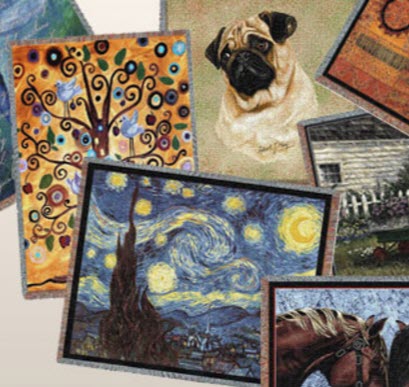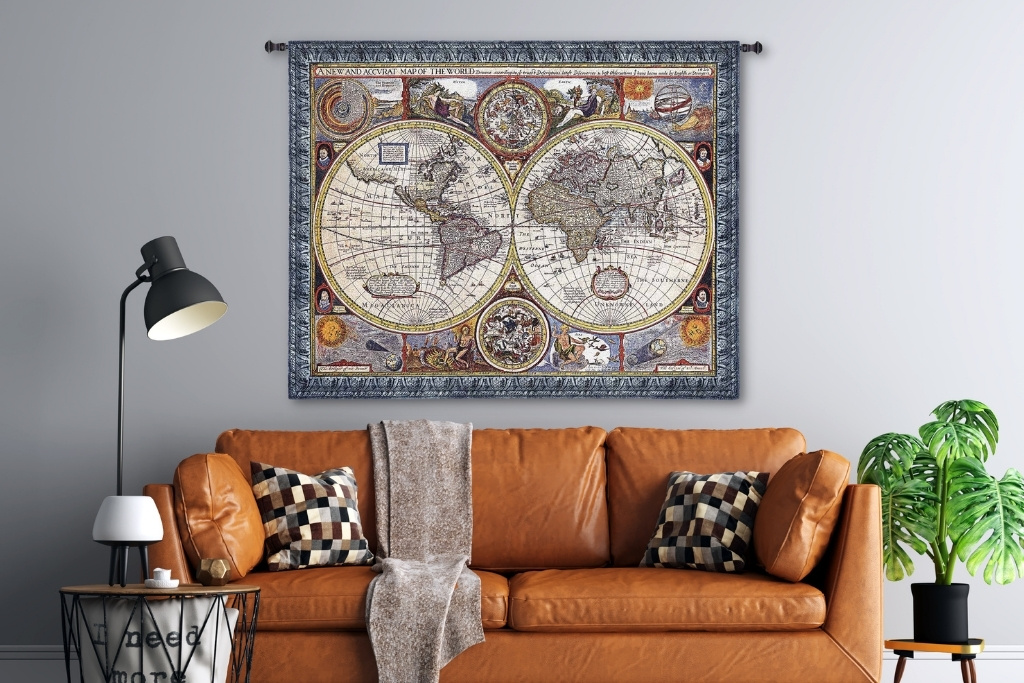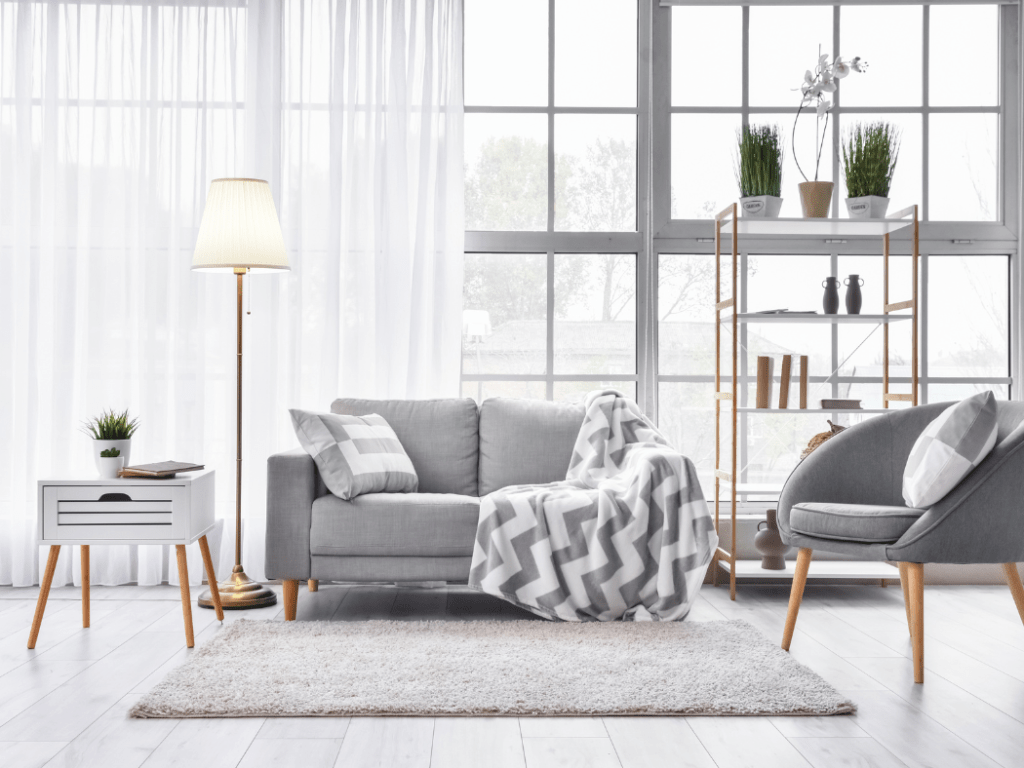Interior design plays a big role in shaping the look and feel of your living space. This guide focuses on using textiles and wall art to refresh and update your home.
Imagine stepping into a space where every corner reflects a unique story, where the walls and furnishings don’t just fill the room but also speak to the soul. This isn’t just about decorating; it’s about creating an environment that resonates with personal style and warmth. In the realm of home decor, the magic often lies in the details, specifically through the use of textiles and wall art. These elements are not just accessories; they are the essence of a home’s personality, offering endless possibilities to infuse color and texture into living spaces.
Textiles serve as the unsung heroes of home comfort and aesthetics. From the soft embrace of a well-chosen throw to the tactile pleasure of textured cushions, these fabric-based wonders can transform any area into a haven of comfort and style. Whether draped over a chair, laid across a bed, or even displayed on walls, textiles bring a layer of warmth and comfort that is both seen and felt.
Wall art, on the other hand, acts as the visual storyteller of a home. It goes beyond decoration, offering a glimpse into the homeowner’s world. Through carefully selecting pieces, a blank wall transforms into a canvas that expresses personal tastes, interests, and even life philosophies. The diversity of wall art, from paintings and prints to textile wall art, allows for a unique exploration of color, texture, and pattern.
Textile wall art, a blend of these two dynamic elements, marries the tactile beauty of textiles with the expressive power of wall decor. From a framed textile print to a textile wall hanging, these stand as a testament to creativity and personal expression, showcasing how fabrics can come alive on walls, adding depth, warmth, and a touch of the unconventional to interior spaces.
This guide aims to navigate the rich terrain of textiles and wall art, offering insights on how to shop for, select, order, combine, and display these elements to achieve a harmonious balance between aesthetics and comfort. It’s about transforming a house into a home, a space into a sanctuary, using color and texture as the vehicle for personal expression. Let’s embark on this journey of discovery, where the ordinary becomes extraordinary through the thoughtful integration of textiles and wall art.
Incorporating these elements effectively can create an inviting atmosphere in any home. Let’s get into choosing and combining these items to achieve a refreshed interior design.
First Up: Understanding Colors and Patterns
Color and patterns are important in interior design. They make a big impact on a room’s mood and perceived size. When selecting textiles for your home, consider how they align with the overall design theme and atmosphere you’re trying to create.
Colors can influence emotions and set the tone for a space. Warm colors like red, orange, and yellow can create a cozy and inviting atmosphere. Cool colors such as blue, green, and purple tend to have a calming effect. Neutral colors like white, beige, and gray, offer flexibility and can serve as a foundation for adding accent colors through accessories.
Patterns add visual interest and depth to a room. When choosing patterns, consider the scale and the room’s size. Large patterns can overwhelm a small space and small patterns may get lost in a larger room. Balancing patterned textiles with solid colors can prevent a space from appearing too busy and ensure a harmonious design.
Incorporating textiles with the right colors and patterns can transform the aesthetic of a room, improve its functionality, and reflect your personal style.
4 Easy Ways to Add Texture to Your Home Decor
Adding texture to your home decor is a straightforward yet effective strategy to create depth, interest, and warmth in your living spaces. Texture plays a crucial role in making a room feel layered and lived-in, inviting touch and enhancing the visual appeal. From the softness of a plush throw blanket to the rustic charm of woven curtains, incorporating different textures can transform the atmosphere of a room. Here are four easy ways to introduce texture into your home decor, each bringing its own unique flair and comfort.
Couch Covers
Couch covers are an effective tool for updating the look of a room without the need to purchase new furniture. They allow for flexibility in changing styles, colors, and patterns with ease, making them ideal for an interior refresh. Another added benefit is that they help protect your furniture. You probably know how important that is if you have kids or pets.
Some big things to consider when choosing couch covers include:
- Material
- Color
- Pattern
- Fit
Choose a fabric that complements your lifestyle and the room’s usage. Durable materials like cotton blends are suitable for high-traffic areas, while luxurious fabrics like velvet can add a touch of elegance to formal living spaces.
Selecting the right color and pattern is important when integrating the couch seamlessly into your room’s design. Use solid colors for a minimalist look or patterns to add vibrancy and interest. Make sure the chosen colors work with the room’s existing color palette.
A well-fitting couch cover can look as good as new upholstery. Measure your sofa accurately to ensure a snug fit, and look for covers with elastic edges for easy adjustment. Proper installation is key to achieving a polished look.
Using couch covers as part of your interior design strategy can dramatically change a room’s appearance. It’s a cost-effective and simple way to keep your living space looking up to date.
Throw Blankets & Pillows
Throw blankets and pillows are the quintessential accessories for adding texture to any room. They offer an immediate invitation to relax and are a simple way to experiment with textures without overwhelming the space.

Mix and match materials like chunky wool, soft fleece, faux fur, and textured cotton to create a layered look that appeals to the senses. The beauty of throw blankets and pillows lies in their versatility; they can be easily swapped out according to season or mood, making them perfect for those who love to update their decor regularly.
Area Rugs
An area rug can anchor a room, define its purpose, and add a substantial amount of texture and color. The variety of materials available—wool, jute, sisal, silk, and synthetics—means there’s an option for every aesthetic and practical need. A high-pile rug adds softness and warmth, ideal for creating a cozy atmosphere in living rooms and bedrooms. In contrast, a flat-weave or low-pile rug offers a cleaner look, suitable for dining rooms and kitchens. Beyond material, the rug’s weave itself—braided, looped, knotted—adds another layer of texture and visual interest to the floor.
Curtains and Drapes
Curtains and drapes are powerful tools in the texture-adding arsenal. They frame windows, influence the room’s lighting, and add height and drama. The choice of fabric is key to the texture they bring; sheer curtains can add a light, airy feel, while heavy velvet or brocade drapes lend a touch of luxury and depth. For a more natural and rustic vibe, consider linen or burlap. Layering curtains, such as combining sheers with heavier drapes, can also create a rich, multifaceted look that adds complexity and warmth to the room.

Incorporating texture into your home decor doesn’t have to be daunting. You can easily add depth, interest, and comfort to your living spaces through these four methods, creating a home that invites touch and exploration.
Adding Textile Wall Art
Wall art plays a significant role in interior design. It helps add depth, character, and personal expression to a space. It can serve as a focal point or complement the overall design theme. When choosing wall art for your home, consider the following aspects to ensure it enhances your space effectively:
- Style of Art – Choose art that reflects your style and the atmosphere you’re trying to create. This could range from calming landscapes for a serene vibe to vibrant abstract pieces for a more dynamic feel. The art should resonate with you personally, as it significantly contributes to the ambiance of your home.
- Size – The size of the art should be in proportion to the wall space and furniture it accompanies. Large pieces can create a statement in spacious rooms, while smaller pieces can be grouped together in a gallery wall to fill a compact space effectively.
- Placement – Hang art at eye level for optimal viewing. Consider the room’s layout and furniture placement to ensure the art complements other elements. In living rooms, art should be centered over the sofa or mantel to create a balanced look.
- Coordinate with Your Decor – Wall art should coordinate with the room’s color scheme and style. It doesn’t have to match exactly but should share similar hues or themes with the room’s textiles and furnishings. This creates a cohesive and well-thought-out design.
Incorporating wall art is a strategic way to personalize your interior design. Thoughtfully selected and placed art can transform a room, making it more visually appealing and reflective of your unique taste. Some of the most popular ways to incorporate textiles into your home’s wall decor include:
Woven Tapestries
Woven tapestries have a storied history, showcasing skilled craftsmanship through intricate designs handwoven into fabric. These pieces vary from depicting historical scenes to abstract compositions, serving as dynamic focal points in a room. The texture and detail in each woven wall tapestry will add a layer of complexity to interior spaces, making them an essential element for any art collector.

Macrame Wall Hangings
Macrame wall hangings reintroduce the art of knotting into modern decor, offering a blend of texture and design through handcrafted cotton rope creations. The variety in patterns and complexity ranges from minimalistic designs to detailed compositions, providing a bohemian touch to interiors. Each handcrafted piece adds a unique, artisanal quality to the room.
Quilted Wall Hangings
Quilted wall hangings combine fabric art with storytelling, featuring detailed patterns or narratives pieced together from different fabrics. These works add visual appeal and a sense of comfort to spaces, reflecting the quilter’s technical skill and artistic vision. Quilted hangings can transform a space, making them a significant addition to any textile art collection.
Embroidered Wall Art
Embroidered wall art displays the precision of needlework, offering a diverse range of styles, from modern designs to traditional motifs. This type of textile art utilizes various stitches to create depth and texture, allowing for detailed and vibrant creations that stand out against the fabric background. Embroidered pieces are notable for their craftsmanship and ability to convey intricate themes and patterns.
Fabric Panels
Fabric panels provide a straightforward approach to integrating textile art, featuring either custom or vintage fabrics with bold prints or artist-designed motifs. These panels can be adapted to the desired aesthetic, either hung loosely for a relaxed look or mounted on a frame for a more structured appearance. Fabric panels allow for customization, enabling a tailored approach to textile wall art.
Framed Textiles
Framed textile art bridges the gap between traditional textiles and framed artwork, offering a method to display and preserve fabric pieces. This technique is suitable for various textiles, from antique tapestry fragments to modern embroidered art. Framing textiles not only highlights the craftsmanship but also elevates the piece to a formal art form, suitable for sophisticated interior designs.
Incorporating textile wall art into interiors is not merely about decoration but about adding historical, artisanal, and aesthetic value to a space. Each type of textile art, from tapestries to framed textiles, offers a unique opportunity to enhance the character and ambiance of a room, making it an integral aspect of thoughtful interior design.
Mixing Textures
Incorporating a variety of textures into your interior design is important to create a rich and engaging environment. Textures add depth and interest, making spaces feel more inviting and comfortable. Here are straightforward strategies for mixing textures in your home:
Combine different fabric textures across your space, from the smoothness of silk to the roughness of burlap. This contrast can be applied through throw pillows, blankets, and couch covers, offering tactile diversity that enhances the room’s comfort and aesthetic appeal.
Integrate natural textures like wood, stone, or bamboo through furniture, flooring, or decorative items. These materials bring an earthy, warm feel to the room and pair well with various textiles, adding layers of visual and tactile interest.
Incorporate metal finishes, such as brass, copper, or stainless steel, through fixtures, frames, or furniture details. Metal accents can add a sleek, modern touch to the room, contrasting nicely with softer fabrics and natural textures.
Area rugs and carpets are excellent for adding texture underfoot. Choose materials that contrast your existing flooring to define spaces and add coziness to the room.
A Note on Appropriate Lighting
Effective lighting and carefully chosen accessories are crucial for complementing textiles and wall art, completing the interior design of a space. Here are some ways to improve the lighting in your space:
- Layered Lighting – Incorporate a mix of ambient, task, and accent lighting to illuminate your space effectively. Ambient lighting provides overall light, task lighting focuses on specific areas for reading or work, and accent lighting highlights architectural features or artwork. This combination ensures that textiles and art are properly showcased.
- Natural Light – Maximize the use of natural light by keeping windows unobstructed. Sheer curtains or blinds can help diffuse light, reducing glare while illuminating textiles and wall art flatteringly.
- Reflective Lighting – Use mirrors strategically to reflect light and art, making rooms appear larger and brighter. Placing a mirror opposite a window can increase natural light while positioning one to reflect a piece of art can double its impact.
Conclusion
Integrating textiles and wall art into your home decor is a dynamic way to infuse personality and warmth into your living space.

When thoughtfully selected and combined, these elements can transform any room into a more inviting and cohesive environment. Here are the most important takeaways:
- Balance color and pattern with your existing decor.
- Use couch covers for an instant, cost-effective transformation.
- Choose wall art that reflects your personal style and complements the space.
- Mix textures to add depth and interest to your interiors.
- Improve your design with the right lighting and accessories to tie everything together.
Start with small changes and experiment with different textiles, art pieces, and accessories to discover what best reflects your unique taste and lifestyle.

